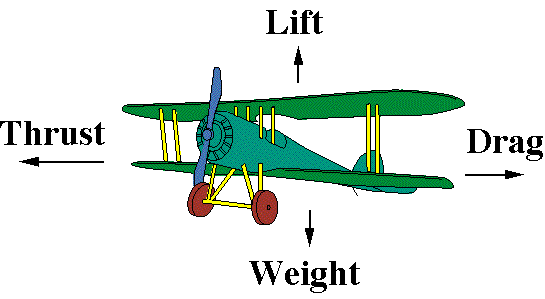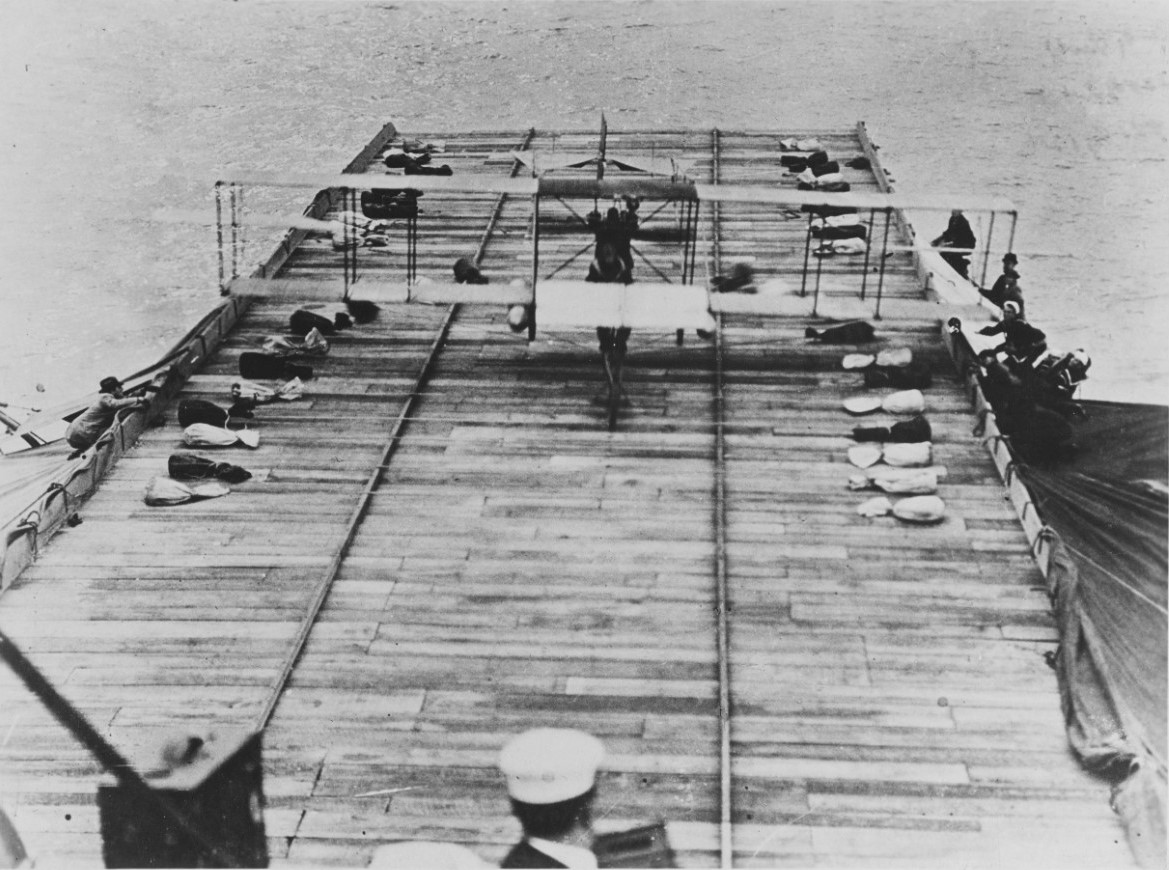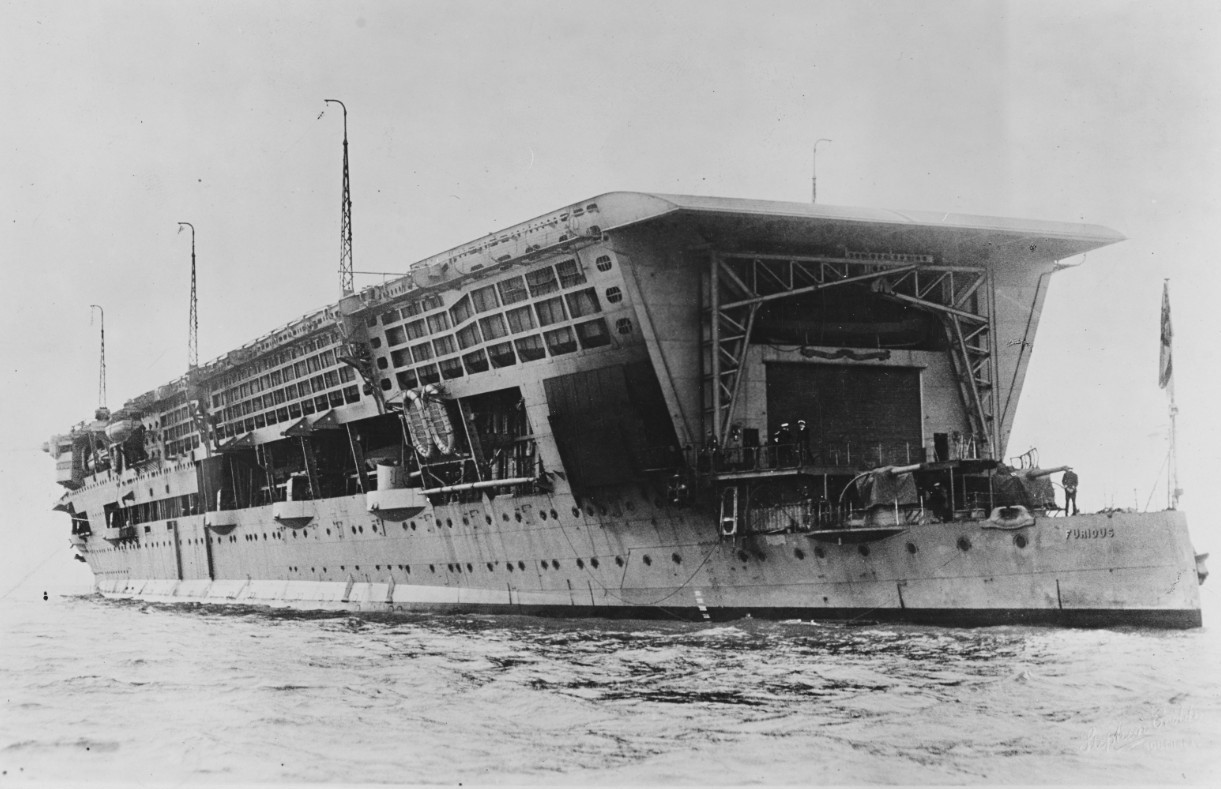Before we get into the theory of operating aircraft from a ship, we need to cover some basics of aviation. Fixed-wing aircraft work by moving through the air, and using that movement to create higher pressure on the bottom of their wings, creating a force we call lift.1 To stay in the air, the plane needs to generate lift to match its weight. The faster the plane moves, the more lift is created,2 so there is a speed below which the plane will fall out of the sky, known as the "stall speed".3 One of the key tasks of the pilot involves making sure it never goes below stall speed, at least when you are close to things you don't want to hit, like the ground or the sea.

Forces on an aircraft, a graphic I am legally required to use at this point
For land-based aircraft, this means the task of taking off and landing is simple enough. Get a long, flat piece of ground, put some asphalt on it, and make sure you have a safe margin above stall speed when you don't have wheels on it. Because there's a lot of ground, it doesn't matter too much if the required distance is several thousand feet. But it's annoying to build a ship much over a thousand feet long, so if you want to fly fixed-wing aircraft from ships, you'll need to be clever. First, it's important to realize that the airplane can't tell the difference between air moving past the wings because it's moving through the air, and air moving past the wings because the air is moving past it. If you had an airplane with a stall speed of, say, 30 kts, and there was a 30 kt wind, you could simply point it into the wind and take off straight up without using the engine.4 Now, land-based aircraft can take advantage of this, but it would take a lot of land to be able to align with the local winds no matter which way they were blowing, so the people building airports generally just figure out which way they usually blow and build the runways accordingly, with some acceptance of crosswinds.5 But ships can move, and thus can both align their runways with the prevailing winds and use their speed to add to the natural wind. This is important because every knot of what is known as "wind over deck" is a knot of airspeed the plane doesn't need to gain before it runs out of deck and falls into the ocean.

Ely almost falling off Birmingham
Now, in the very early days of aviation, stall speeds were incredibly low, so the amount of deck required was equally low. The first plane to take off from a ship, Eugene Ely's Curtiss Model D, had a flying speed of only 30 kts, and Ely took off from the stationary Birmingham into a 10 kt wind. But he had only 50 hp and a 53' run down the sloped deck, so this wasn't quite enough and his propellers brushed the water before he got to flying speed. But if he had been willing to wait for Birmingham to get up to speed, as had been the original plan, it would have been no trouble at all, as indeed was the case for Cmdr Charles Sampson of the Royal Navy, who made the first takeoff from a moving ship, flying from HMS Hibernia two years later.

Ely landing on Pennsylvania with the aid of arresting gear
But taking off is only half of the battle, and it turned out to be the easier half at that. Eugene Ely had made the first landing on a stationary ship on a ramp aboard the armored cruiser USS Pennsylvania in January 1911. To ensure the plane stopped, 22 ropes were stretched across the deck, each attached to a pair of 50-lb sandbags, and hooks were fitted to the plane, another Curtiss Model D, to grab them. In case things went wrong, a canvas barrier was erected at the end of the deck. The original plan had been to land while the ship was in motion, but the captain didn't think he had sufficient maneuvering room in San Francisco Bay, and Ely made the landing onto a stationary ship with a 10-kt tailwind, which meant that he floated over half of the wires before putting the plane on the deck, and stopped with only 50' to spare. Later experience would show that a landing underway would probably not have been possible, as the turbulence coming from the superstructure ahead of the flying-on deck would have been too much for Ely to cope with in the light aircraft of the day.

The stern of HMS Furious, with door into the hangar clearly visible
The obvious solution was to make the plane capable of landing on the water, generally by bolting some floats to it, which in turn raised that as a possibility for taking off as well. Although the drag of the floats meant that this wasn't always easy for the anemic engines of the day, it was safer than trying to take off from a deck. Equally importantly, a seaplane could continue to operate even while the carrier was anchored, which meant pilots could be trained and operations ashore supported without getting underway. This was enough of a concern that a stern deck to operate seaplanes from remained a requirement for British carriers into the 1930s. But while using the sea as a runway worked well for anchored ships, it was far less suitable for operations with the fleet, and we'll look at the solutions the British pursued next time.
1 Yes, this section is going to be simplified. Do not attempt to build or operate a plane based only on what you learn here. If you want to understand a bit more, try Aerodynamics for Naval Aviators. ⇑
2 Aerodynamics note: There are three factors here: speed (squared), lift coefficient (which the pilot can alter by raising or lowering the nose), and atmospheric density (which varies with altitude and temperature). Because we're talking about taking off and landing on ships, we will assume that lift coefficient is about as high as it can go, and that density is fixed, because the highest aircraft carriers ever were only 577' up, and even that isn't really enough to matter. Temperature does affect stall speed for carrier ops, but we can mostly ignore that right now. Also worth calling out explicitly is that a plane's weight changes during flight, so stall speed on landing is lower than on takeoff. ⇑
3 Aerodynamics note: This is a slight simplification of how stalls actually work. If the pilot raises the plane's nose, the lift coefficient goes up until a point, after which it collapses and the plane stops flying. This usually happens when trying to maintain level flight while going too slowly. The alternative is to allow the plane to go downward and trade altitude for speed, a procedure known as "gliding". It's also worth noting that in the real world, you want to make sure you have some margin above stall speed because, say, a gust of wind could push you past the critical point, and falling out of the sky is generally considered a bad thing, but I will treat "stall speed" and "landing speed" as synonymous here for simplicity. ⇑
4 Aerodynamics note: this wouldn't quite work. First, if you're on the ground, you can't choose the angle that gives the most lift. Second, you'd need some margin over stall speed to be able to generate excess lift to climb. Third, the wind on the airplane would also push it backwards (a phenomenon known as "drag") and that would slow it down once it was airborne, which would probably cause it to glide back to the ground. But a few planes, most notably the An-2, are actually capable of landing straight down in high winds by "flying" forward at the same speed they are being blown backwards. ⇑
5 Back in the old days, when stall speeds were much lower, there were a few places where big circular fields were laid out that essentially gave a runway in every direction. But planes needing better and longer runways killed them off in the 30s. More recently, some people propose solving this with a circular runway, which solves this problem at the cost of so many others I'm not even going to bother. ⇑

Comments
I think the Wolverine/Sable operations on Lake Michigan are probably going to hold the altitude record for carrier operations indefinitely (unless they also went to Superior?).
You are not wrong, and that's higher than Gatun. I will correct.